Your backyard’s potential extends far beyond a simple lawn; it’s a canvas waiting to be transformed with carefully curated container gardens. From space-saving vertical herb displays to dramatic tropical specimens, potted plants offer flexibility and instant impact without major landscape changes. You’ll discover how to combine different plant types, colors, and textures while maximizing limited space through strategic container placement and plant selection. Let’s explore these versatile options that can turn any outdoor area into your personal garden sanctuary.
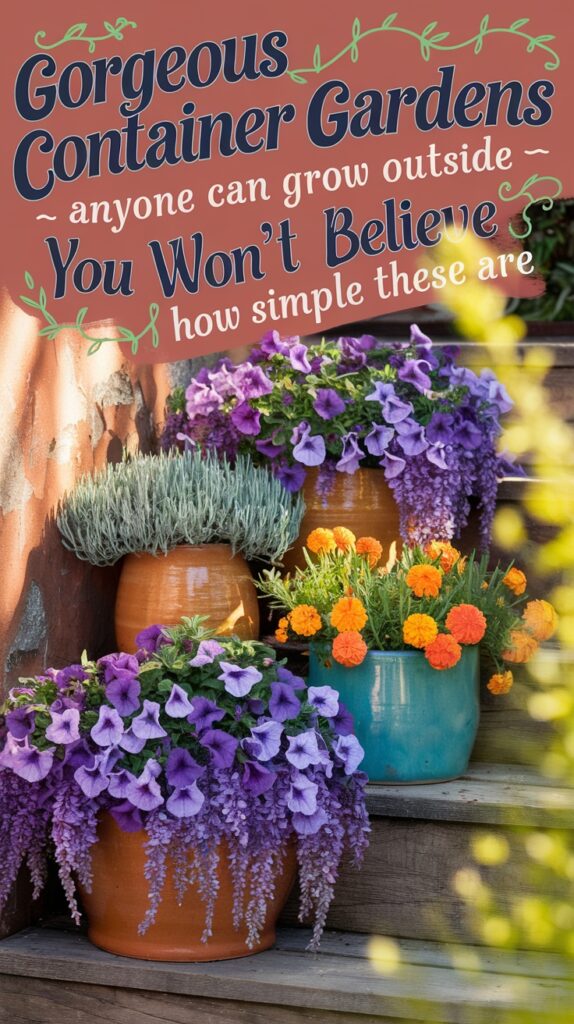
Contents
- 1 Vertical Herb Gardens in Tiered Containers
- 2 Colorful Annual Flowers for Instant Impact
- 3 Low-Maintenance Succulent Arrangements
- 4 Mixed Container Gardens With Thriller, Filler, and Spiller Plants
- 5 Climbing Plants on Decorative Trellises
- 6 Edible Container Gardens for Fresh Produce
- 7 Shade-Loving Plants for Covered Spaces
- 8 Native Plant Containers for Local Wildlife
- 9 Statement Tropicals in Oversized Pots
- 10 Year-Round Evergreen Container Displays
Vertical Herb Gardens in Tiered Containers
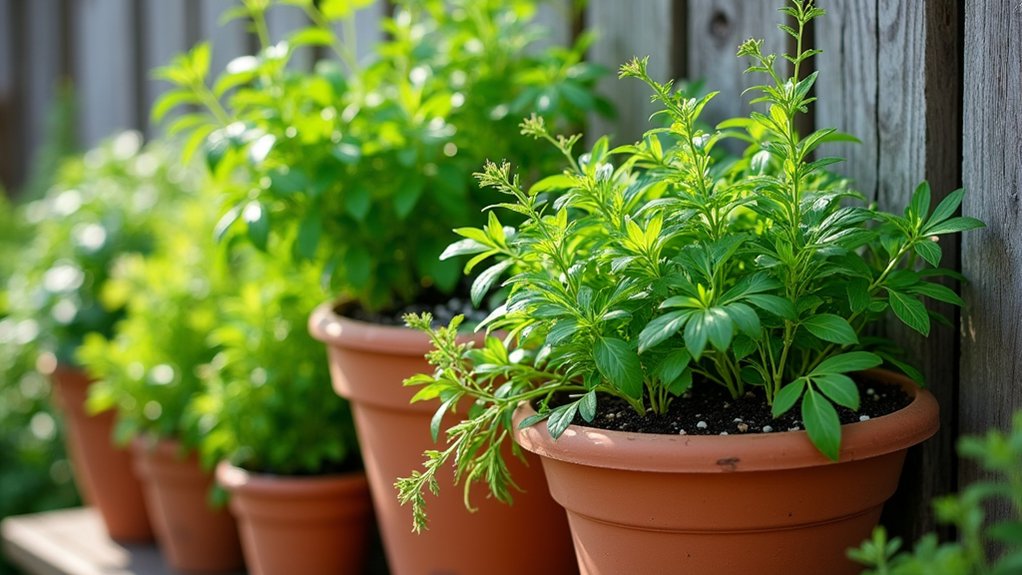
Vertical herb gardens in tiered containers offer a space-saving solution for growing multiple herbs in a compact area while creating an attractive visual display. These gardens typically feature stacked or cascading containers arranged in a pyramid-like formation, with each level housing different herb varieties.
The setup allows for efficient water drainage from upper to lower tiers and provides easy access for harvesting herbs at different heights, making it ideal for small patios or balconies.
- Full sun to partial shade, with at least 6 hours of direct sunlight daily
- Well-draining potting soil mixed with perlite or coarse sand
- Water when top inch of soil feels dry, ensuring drainage holes remain clear
- Container depth of at least 6-8 inches for adequate root growth
- Spacing of 4-6 inches between plants within each tier
- Temperature range of 65-70°F (18-21°C) for most herbs
- Monthly feeding with balanced, water-soluble fertilizer
Regular pruning and harvesting are essential for maintaining a healthy vertical herb garden. Trim plants frequently to encourage bushier growth and prevent them from becoming too leggy or overwhelming neighboring herbs.
Remove any yellowing or dead foliage promptly to prevent disease spread, and rotate the tiered container periodically to ensure all plants receive equal light exposure.
In winter, consider moving tender herbs to a protected location or adding frost protection when temperatures drop.
Colorful Annual Flowers for Instant Impact
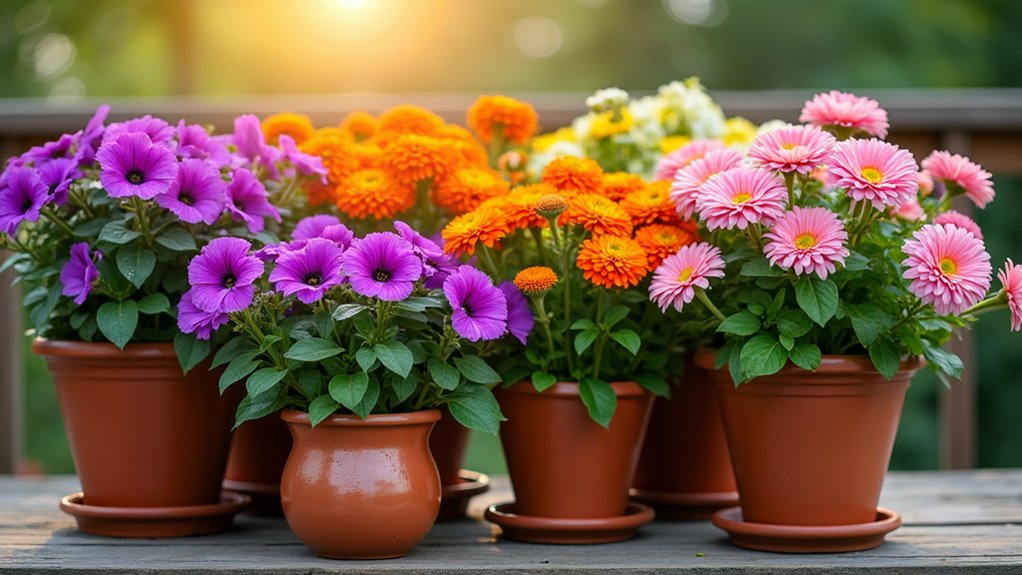
Annual flowers provide immediate bursts of color and visual interest to potted gardens, blooming continuously throughout a single growing season. These vibrant plants come in countless varieties, from petunias and marigolds to zinnias and cosmos, offering a spectrum of heights, colors, and flower forms that can transform a backyard container garden into a stunning display from spring through fall.
- Light: Most annual flowers require 6-8 hours of direct sunlight daily, though some varieties like impatiens prefer partial shade.
- Water: Keep soil consistently moist but not waterlogged; water when top inch of soil feels dry.
- Soil: Well-draining, nutrient-rich potting mix with added organic matter.
- Container: Pots with adequate drainage holes, sized appropriately for mature plant size.
- Temperature: Protect from frost; optimal growing temperature between 65-75°F.
- Spacing: Follow specific variety recommendations, typically 6-12 inches apart.
Regular deadheading of spent blooms encourages continuous flowering and prevents seed formation, directing the plant’s energy toward producing new flowers.
Feed plants with a balanced, water-soluble fertilizer every 2-3 weeks during the growing season, and pinch back leggy growth to maintain compact, bushy forms.
Monitor for signs of pest damage or disease, particularly in humid conditions, and ensure adequate air circulation between plants to prevent fungal issues.
Low-Maintenance Succulent Arrangements
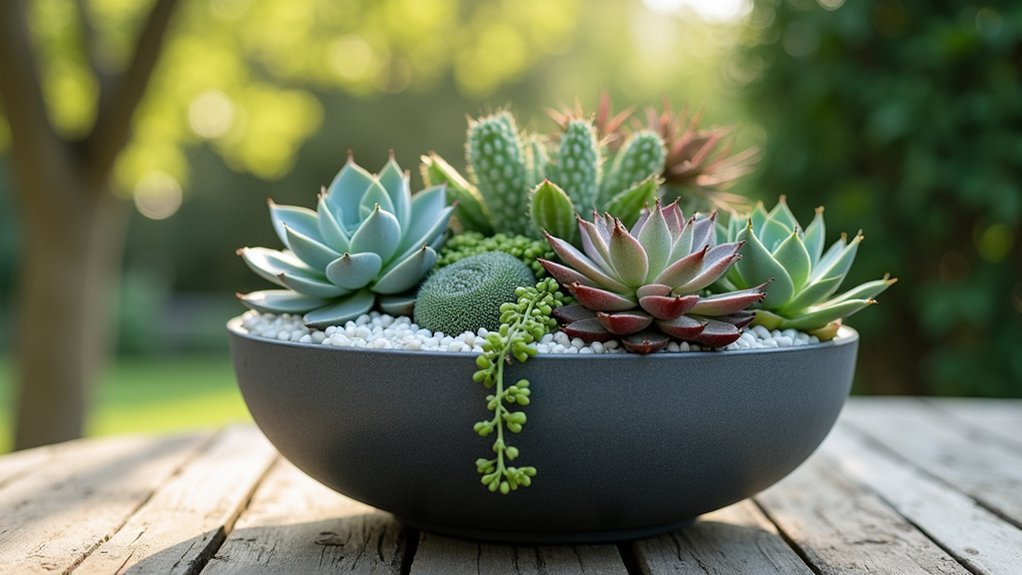
Succulent arrangements in containers offer striking visual interest with minimal effort, featuring plants in various shapes, sizes, and colors that naturally complement each other. These drought-resistant plants create living sculptures with their thick, fleshy leaves arranged in geometric patterns, ranging from tight rosettes to trailing forms, often in muted blues, greens, and purples, with some varieties displaying vibrant reds and yellows when stressed.
- Light: Bright, indirect sunlight with some protection from intense afternoon sun; 4-6 hours of sunlight daily
- Water: Allow soil to dry completely between waterings; reduce watering in winter
- Soil: Fast-draining cactus or succulent mix
- Container: Pots with drainage holes; terra cotta preferred
- Temperature: 60-80°F (15-27°C); protect from frost
- Spacing: 2-3 inches between plants to allow for growth
- Humidity: Low to moderate; good air circulation required
Regular maintenance involves removing dead or yellowing leaves, rotating containers quarterly for even growth, and inspecting for signs of pests like mealybugs or scale insects.
Pruning leggy growth encourages compact development, while removing offsets (baby plants) prevents overcrowding and provides opportunities for propagation.
Fertilize sparingly during the growing season with a balanced, water-soluble fertilizer diluted to quarter strength.
Mixed Container Gardens With Thriller, Filler, and Spiller Plants
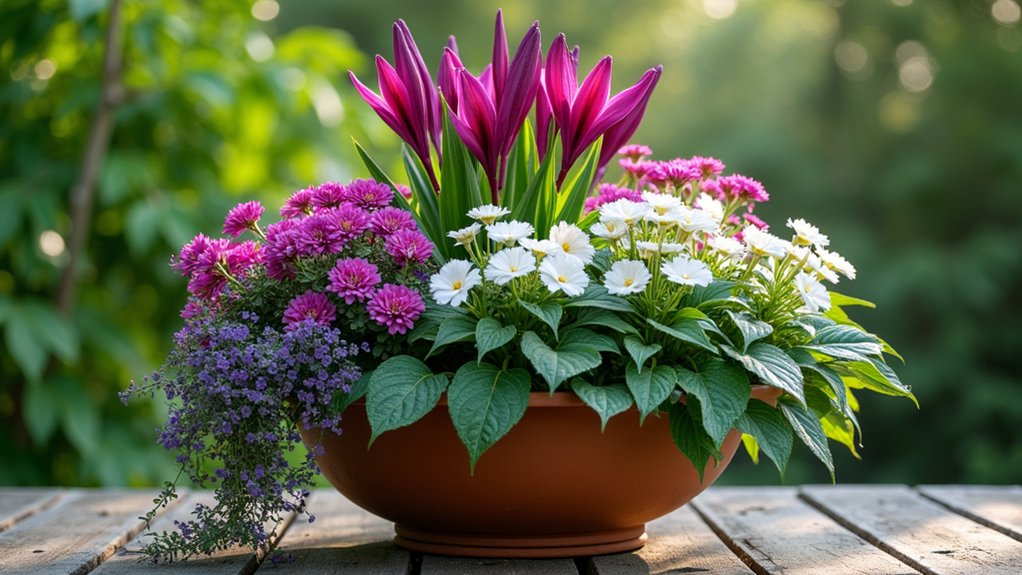
Mixed container gardens featuring thriller, filler, and spiller plants create dynamic, eye-catching arrangements using three distinct plant types in a single container. The “thriller” serves as the focal point with tall, dramatic plants placed in the center or back of the container. “Fillers” are medium-height, bushy plants that add volume and texture around the thriller. “Spillers” cascade over the pot’s edges, softening the arrangement and creating vertical interest through trailing foliage or blooms.
Growing Conditions:
- Container must have adequate drainage holes
- Use high-quality potting mix, not garden soil
- Most combinations thrive in full to partial sun, depending on plant selection
- Container size should be at least 12 inches deep and wide
- Water thoroughly when top inch of soil feels dry
- Feed with balanced, water-soluble fertilizer monthly during growing season
- Place container where appropriate for the light requirements of all plants included
Regular pruning and deadheading keep mixed container gardens looking their best throughout the growing season. Remove spent blooms and yellowing foliage, and trim back aggressive plants that might overwhelm their companions.
Monitor the growth patterns and adjust plant positions if needed, ensuring thriller plants don’t block light from shorter companions. Rotate the container quarter-turns weekly to promote even growth, and replace seasonal plants as needed to maintain the desired aesthetic year-round.
Climbing Plants on Decorative Trellises
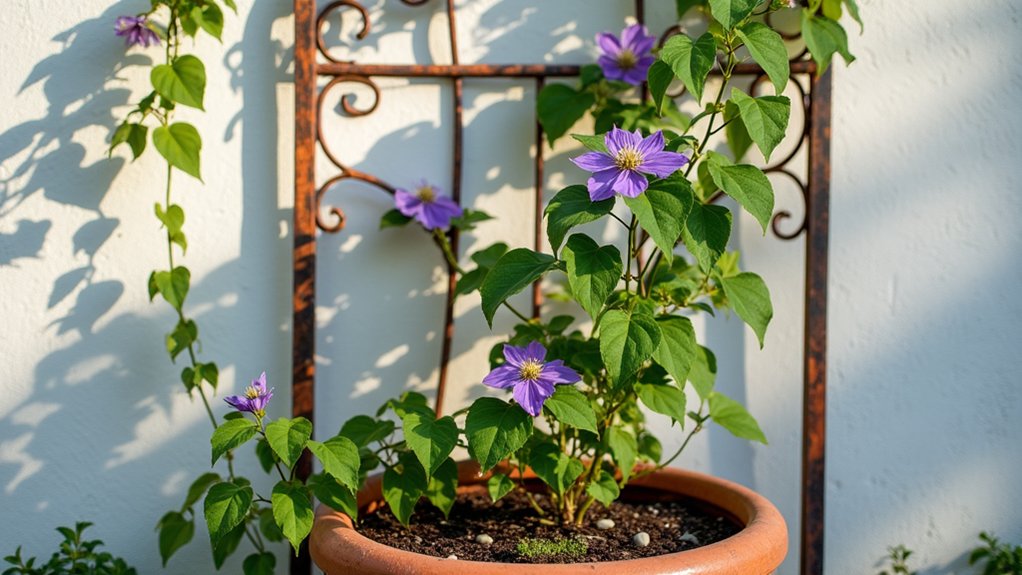
Climbing plants paired with decorative trellises create stunning vertical garden features that transform ordinary patio spaces into lush, living walls. These versatile combinations can include flowering vines like clematis and jasmine, or edible options such as pole beans and peas, all growing upward on beautiful lattices, metal frameworks, or wooden structures that serve as both functional support and architectural elements in the garden design.
- Full sun to partial shade, depending on specific plant variety
- Consistent moisture with well-draining soil
- Rich, organic potting mix with balanced nutrients
- Large containers (minimum 18 inches deep) to support root development
- Protection from strong winds to prevent trellis toppling
- Regular fertilization during growing season
Regular maintenance of climbing plants on trellises involves training new growth along support structures, pruning away dead or tangled sections, and monitoring for pest issues in the dense foliage.
Securing loose vines before they become unmanageable helps maintain the desired shape and prevents damage to tender stems. During active growing periods, pinching back growing tips encourages bushier growth and more abundant blooms, while periodic cleaning of the trellis structure prevents the accumulation of debris that could harbor disease.
Edible Container Gardens for Fresh Produce
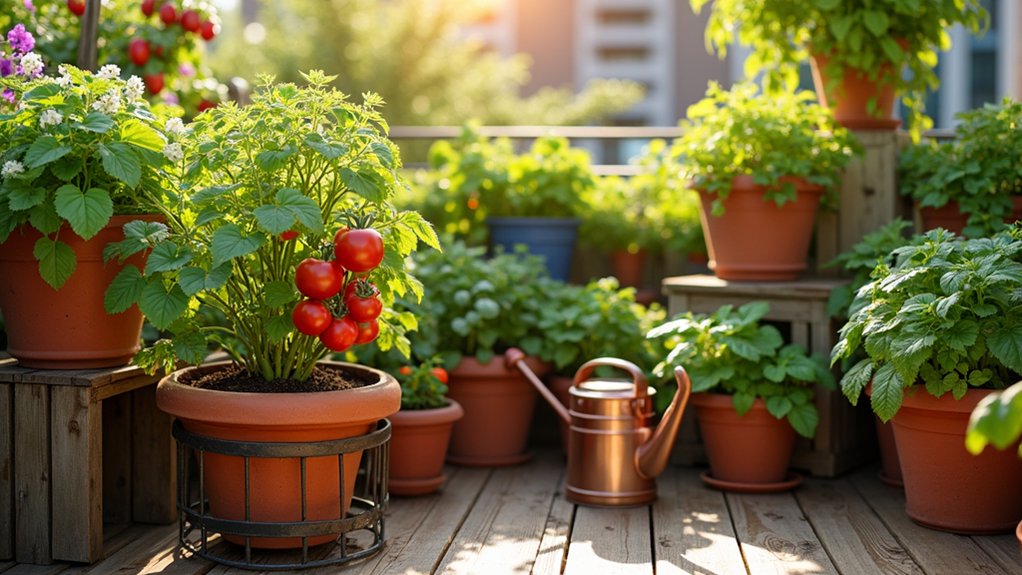
Edible container gardens transform outdoor spaces into productive mini farms, allowing you to grow fresh vegetables, herbs, and fruits right on your patio or deck. These gardens typically feature a variety of pots and containers arranged to maximize growing space while creating an attractive display.
Containers can range from traditional clay pots to repurposed items like wooden boxes or hanging baskets, filled with complementary plant combinations such as tomatoes surrounded by companion herbs, or vertical arrangements of strawberries cascading over pot edges.
- Light Requirements: 6-8 hours of direct sunlight daily for most edibles; partial shade tolerance for leafy greens
- Soil Needs: Well-draining potting mix enriched with compost; pH between 6.0-7.0
- Water Requirements: Consistent moisture; water when top inch of soil feels dry
- Container Size: Minimum 12 inches deep for most vegetables; larger pots (5+ gallons) for tomatoes and peppers
- Temperature Range: 60-80°F optimal for most edibles
- Spacing: 2-3 inches between leaf lettuce, 12-18 inches for tomatoes and peppers
Regular maintenance is crucial for productive edible container gardens. Rotate containers every few days to ensure even growth and prevent plants from becoming leggy.
Feed plants with organic liquid fertilizer every two weeks during the growing season, and remove any yellowing or diseased leaves promptly to prevent spread.
Harvest vegetables regularly to encourage continuous production, and prune herbs often to maintain bushiness and prevent flowering, which can make leaves bitter.
Shade-Loving Plants for Covered Spaces
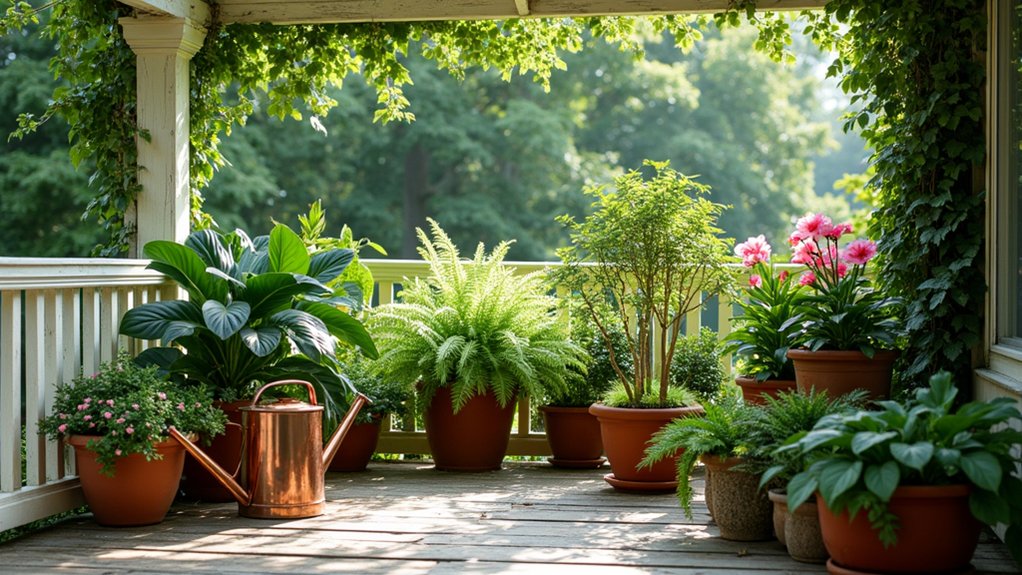
Shade-loving plants are perfect solutions for covered patios, porches, and other low-light outdoor spaces where sun-loving varieties struggle to thrive. These adaptable plants have evolved to flourish in filtered light conditions, often featuring broad, dark green leaves that efficiently capture available light.
Common shade-loving options include hostas, ferns, begonias, and peace lilies, which add lush foliage and sometimes delicate blooms to otherwise challenging growing spaces.
Growing Conditions:
- Light: Prefer filtered to full shade, avoiding direct afternoon sun
- Water: Consistent moisture with well-draining soil; avoid waterlogged conditions
- Soil: Rich, organic potting mix with good drainage
- Temperature: Most prefer moderate temperatures between 60-75°F
- Humidity: Medium to high humidity levels
- Container: Must have drainage holes and be appropriately sized for the plant
Regular grooming and strategic placement are key to maintaining healthy shade-loving plants. Remove any yellowed or dead foliage promptly to prevent disease spread and maintain aesthetics.
Rotate containers occasionally to ensure even growth, as even shade-loving plants may grow toward available light. During winter months, move containers closer to windows or light sources, and reduce watering frequency while maintaining humidity through misting or pebble trays.
Native Plant Containers for Local Wildlife
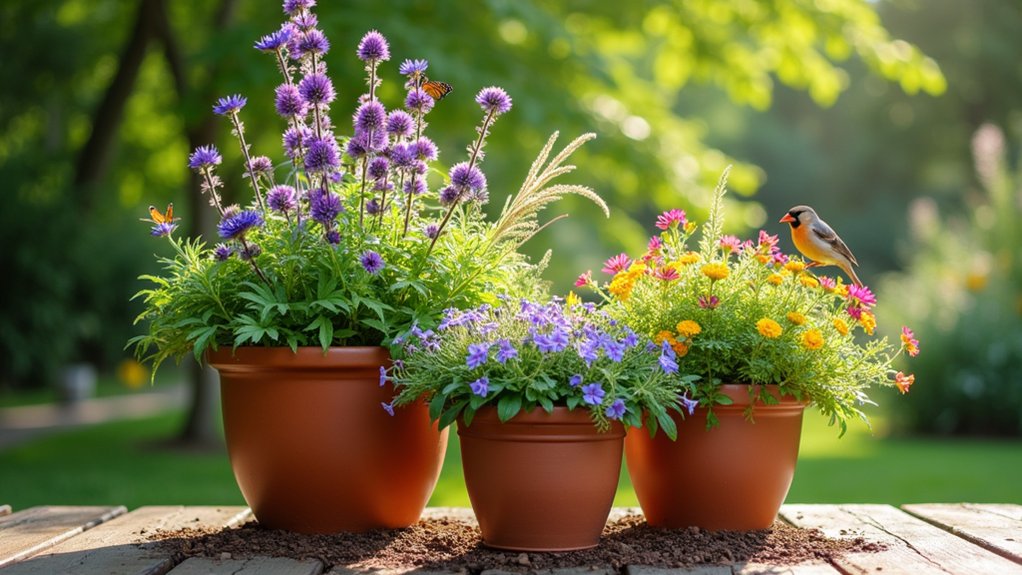
Native plant containers designed to attract local wildlife transform ordinary patios and decks into vibrant microhabitats that support indigenous birds, butterflies, and beneficial insects.
These containers typically feature a mix of regional flowering plants, native grasses, and small shrubs arranged in layers to mimic natural ecosystems. The combination of different heights, textures, and blooming periods creates both visual interest and functional habitat spaces where local fauna can feed, shelter, and potentially nest.
- Full to partial sun exposure, depending on specific native plant selections
- Water needs vary by region – generally moderate, allowing soil to dry slightly between waterings
- Well-draining potting soil mixed with local soil to provide familiar growing medium
- Container size minimum 16 inches deep for adequate root development
- Group containers for increased habitat value and humidity control
- Position near existing landscape features that wildlife already visits
Regular deadheading of spent blooms, selective pruning to maintain shape, and monitoring for signs of pest damage help maintain the health of native container gardens.
Adding a layer of organic mulch helps retain moisture and regulate soil temperature while mimicking natural ground conditions. Avoid chemical pesticides to protect visiting wildlife, and instead focus on creating balanced plant communities that naturally resist problems.
Replace about one-third of the potting mix annually to replenish nutrients and maintain proper drainage.
Statement Tropicals in Oversized Pots

Statement tropicals in oversized pots create bold, dramatic focal points in backyard spaces through their large, architectural foliage and impressive scale.
Plants like bird of paradise, banana trees, elephant ears, and giant philodendrons command attention when planted in substantial containers, creating an instant tropical atmosphere. The oversized pots not only accommodate extensive root systems but also provide visual weight and balance to match the plants’ grand proportions.
- Light: Bright, filtered sunlight; protect from intense afternoon sun
- Water: Consistent moisture; water deeply when top 2 inches of soil feels dry
- Soil: Rich, well-draining potting mix with added organic matter
- Container: Minimum 24-inch diameter with adequate drainage holes
- Temperature: 65-85°F (18-29°C); bring indoors when temps drop below 55°F (13°C)
- Humidity: 50% or higher; mist foliage regularly in dry conditions
Regular maintenance for statement tropicals includes monthly fertilization during growing season with balanced, water-soluble fertilizer, pruning yellowed or damaged leaves promptly, and rotating pots quarterly for even growth.
Clean leaves with a damp cloth to remove dust and maintain photosynthesis efficiency, and repot every 2-3 years or when roots become visible through drainage holes.
Inspect regularly for pests, particularly spider mites and mealybugs, which are attracted to tropical foliage.
Year-Round Evergreen Container Displays
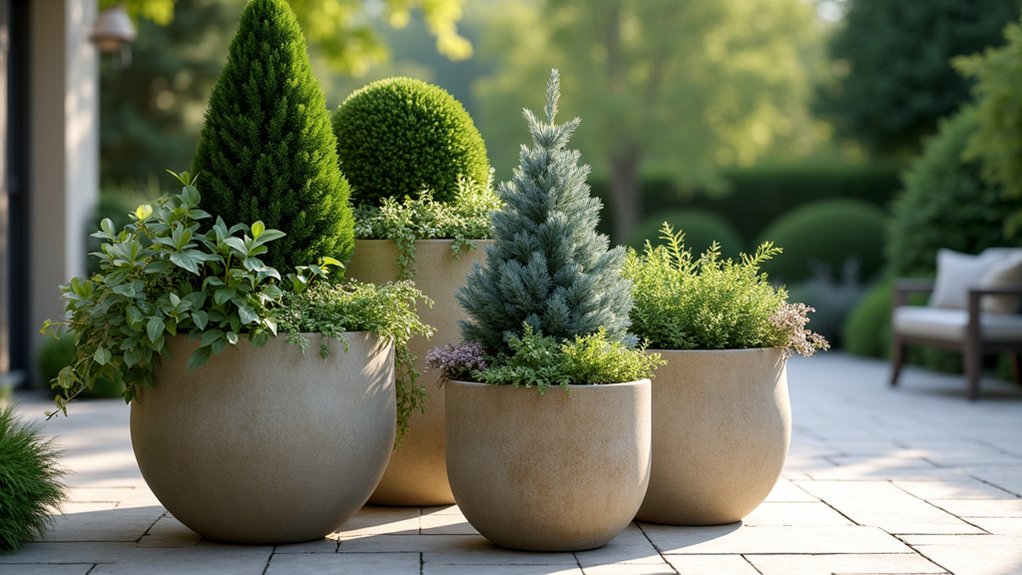
Year-round evergreen container displays offer consistent beauty and structure to outdoor spaces through all seasons, featuring a mix of dependable plants that maintain their foliage year-round. Common choices include dwarf conifers, boxwood, holly, and small-leaved evergreen shrubs, which can be artfully combined with trailing ivy or similar groundcovers for visual interest.
These arrangements typically incorporate varying heights, textures, and shades of green to create dynamic displays that look sophisticated even during winter months.
Growing Conditions:
- Position containers in partial to full sun, depending on specific plant selections
- Ensure excellent drainage through containers with adequate holes
- Use high-quality potting mix specifically formulated for container gardens
- Water deeply but allow soil to dry slightly between waterings
- Protect from harsh winter winds in cold climates
- Maintain consistent moisture levels during hot summer months
- Choose containers at least 2-3 times larger than root balls to allow for growth
Regular maintenance of evergreen container displays involves monitoring soil moisture, especially during extreme weather conditions, and trimming dead or yellowing foliage as needed.
Fertilize with a slow-release fertilizer in spring and mid-summer, and periodically check for signs of pest infestation or disease.
Reshape plants through light pruning to maintain desired form and prevent overcrowding, and periodically rotate containers to ensure even growth on all sides.
